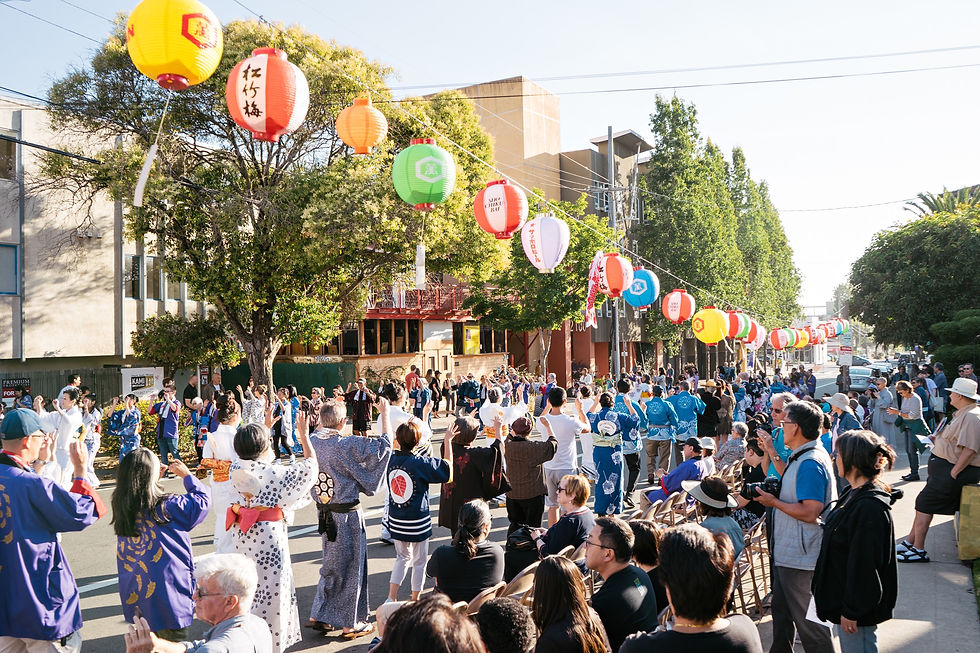
OBON:
GATHERING OF JOY

Every summer, BCA temples celebrate a uniquely American version of the Japanese Obon Festival. Along with traditional folk dancing known as Bon Odori, a variety of food, drinks, games, and entertainment may be offered. All attendees are encouraged to “just dance" as we remember those who have passed on and enjoy the present moment together.
Featured Music
Lantern Song Dance
Commissioned by the BCA Music Committee for the BCA 125th anniversary celebration in 2024, the Bonbu Stories group has created "Lantern Song" and choreographed the "Lantern Song Bon Odori" for use at temple Obon festivals. The recording is downloadable and accompanied by a dance tutorial video. With gratitude to the Bonbu Stories group and their many collaborators, we present the latest new American bon odori.
Composition: Miharu Okamura and Miko Shudo
Lead vocals: Miharu Okamura and Miko Shudo
Arrangement and Production: Jake Abernathie
Koto: Emily (Yoshihara) Imazumi
Choir: Kendall Tani, Sydney Shiroyama, Vicky Zhang, Miharu Okamura, Miko Shudo, Lisa (Horikawa) Orpilla, Michael Murata
Recording Engineer: Miles Senzaki
Recorded at: Grandma's Dojo Studio
Mixing Engineer: Joe Sanders
Mastering Engineer: Sun Room Audio - Dan Coutant
Kangie
Commissioned by the Buddhist Churches of America Music Committee, artist and activist Nobuko Miyamoto
has created the new bon odori, “Kangie” (Gathering of Joy), for use at temple Obon festivals.
The recording is downloadable and accompanied by a dance instruction video. With gratitude to
Nobuko Miyamoto and her many collaborators, we hope you enjoy this recent new American bon odori.
Nobuko Miyamoto: Composer, lyricist, vocals Derek Nakamoto: Composer, arranger Isaku Kageyama: Taiko
Mike Penny: Shamisen Mark Izu: Sho Kaoru Watanabe: Shinobue, ryuteki Kenny Endo: Tsuzumi, percussion
Nancy Sekizawa: Vocals Helen Ota: Vocals
Reverend Masao Kodani: Vocals Reverend Ryuta Furumoto: Vocals Recorded at The Nest, Los Angeles Chris Sorem: Engineer
Bon Odori Music
The Bon Odori, Taiko, Public Music Subcommittee commissioned two bon odori recordings from professional taiko drummer Isaku Kageyama with musicians Sumie Kaneko and David Wells. The resulting tracks, “Aizu Bandaisan” and “Tokyo Ondo,” were completed in 2022 and are available as MP3 files.
In addition, Kageyama released four recordings in 2021: “Hokkai Bon Uta,” “Sohma Bon Uta,” “Tanko Bushi,” and “Yagi Bushi.”
Thank you to Isaku Kageyama and all the musicians for making these tracks free to download and use in Obon Festivals and online programs. The BCA Music Committee appreciates being able to work jointly with the Taiko Community Alliance to make these recordings available.
Bon Odori recordings generously shared by the Chidori Band of San Jose, California for use at temple obon festivals. Thank you to Duane Takahashi, Michael Yoshihara, and all the musicians of the Chidori Band, past and present!
ORIGINS
The Ullambana Sutra
The Obon tradition arose from the story of Mahamaudgalyayana (Mogallana in Pali) and his mother in the Ullambana Sutra. The mother has fallen into a terrible state in the afterlife, and the Buddha advises Mogallana that the only way to assist her is to make offerings to the monks at the end of their rainy season retreat. When Mogallana does so, his mother’s suffering is relieved, causing him to clap his hands and dance for joy.
This story became popular in China for its theme of family respect, and Obon has been held in Japan since 657 CE to express gratitude to our departed loved ones and ancestors.
From a Shin Buddhist perspective, the occasion is not about making supernatural requests or offerings to ghosts. The Ullambana story is a call to reflect on all those who came before us and consider what they gave to our world so we could be here today. Realizing this compassion beyond ourselves, like Mogallana, we are brought to dance joyfully in gratitude.


OBON IN AMERICA
Buddhist minister Yoshio Iwanaga introduced Bon Odori to communities along the North American West Coast in the 1930s (see this exhibit for more early history). As Obon dances attracted large crowds from the surrounding neighborhoods, they evolved into larger festivals with culinary bazaars and cultural demonstrations.
Today, a festival can be found nearly every weekend between June and August. Obon Festivals are typically temples’ largest event of the year and most visible presence in their local communities. Obon dances have been passed from parents to their children and grandchildren, while new dances continue to be developed and introduced each summer. It is a special time for temple communities to come together and orchestrate their own event, while visiting others out of support and friendship.
Taiko drums herald the centerpiece of the Gathering of Joy, when everyone makes a circle around the yagura (tower) for Bon Odori. Whether you dress in traditional Japanese attire or your best beachwear, everyone is encouraged to “just dance.” Setting our egos aside, we find kindness in everyone’s care toward each other, in a friendly wave, or a knowing laugh on the dance line. As the sun sets and the festival lights begin to shine, we think of those who have passed on and celebrate the paths that brought us together in gratitude.

